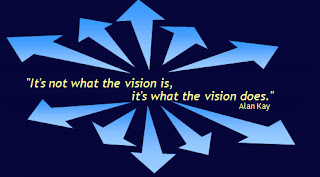 |
| 10 tips for creating a great presentation |
Question 1: What are my goals?
Whether it is to inspire, persuade, or inform, the goal of your presentation is to in some way change or reinforce your audience’s knowledge, opinions, and beliefs.
How do I want to transform my audience? What do I want them to “walk away with” at the end of my presentation? Create a short list of goals for your presentation in simple, concrete terms.
Question 2: What is my main message?
Your audience is bombarded with thousands of messages and ideas every day. Your challenge is to cut through the noise and engage their attention and imagination with a message that is clear, concise, and relevant.
What single statement best expresses my main message? Describe in a single sentence a message that will both engage your audience and accomplish your goals.
 |
| 10 tips for creating a great presentation |
Question 3: What are my key points?
What are the key points that will bring out the most important and meaningful dimensions of my main message? Create a list of key points that will best communicate your message to your audience.
 |
| 10 tips for creating a great presentation |
Question 4: What supports my key points?
The more ways your audience is able to connect with your message, the better they will understand, accept, and remember it.
How many different ways can my key points be validated, clarified, and demonstrated? Develop at least four supporting elements for each key point.
 |
| 10 tips for creating a great presentation |
Question 5: What is my basic story?
Every presentation tells a story.
• Chronological presentations present a sequence of events, moving from the past, through the present, to the future.
• Problem/solution presentations state and explore a problem, analyze the causes, compare and advocate solutions.
• Motivational presentations capture attention, clarify a challenge, show a path forward, visualize the outcome, and deliver a clear call for action.
• Opportunity/action presentations state an opportunity, explore options and risks, and advocate a path forward
• Categorical presentations follow the natural progression or professionally accepted categories of a subject
What is the basic story that will best convey my message? Create a simple visual diagram that links and integrates your key points into a coherent and engaging story. Explore different structural possibilities.
 |
| 10 tips for creating a great presentation |
Question 6: How should the story develop?
Every story has a beginning, a middle and an end.
• The beginning must quickly engage the audience’s interest and attention. It establishes the theme, the pace, and the flavor of the presentation. It builds anticipation and sets expectation.
• The middle unfolds and develops different aspects of the initial theme. It alternates between the big picture and the details; the general and the specific.
• The end summarizes and recapitulates your basic message. It is a call to action.
How can my supporting elements be used to further develop and energize each phase of my story? Select supporting elements that give dimension and continuity to your story. Plug them in to your diagram.
 |
| 10 tips for creating a great presentation |
Question 7: How should I tell the story visually?
• Visuals engage. They capture and focus your audience’s attention during your presentation and make it easier to remember afterward.
• Visuals clarify. They can emphasize important points, illustrate complex concepts, and highlight meaningful patterns in data.
• Visuals unify. They build credibility, consensus, and commitment by giving dimension and vividness to ideas and concepts.
How can visuals be used to strengthen my message and my story? Organize the key ideas and visual supporting elements from your presentation diagram into a sequence of words and images.
 |
| 10 tips for creating a great presentation |
Question 8: How can I best present the story?
How can the truth and importance of my message be conveyed through my voice and body language? Rehearse your presentation. Develop confident mastery of its transitions from topic to topic and slide to slide.
 |
| 10 tips for creating a great presentation |
Question 9: How can I bring the message to life?
How can I deliver a fresh, living message? Be awake to the details of the room and your audience. Treat your audience like participants, rather than spectators. End by asking them to take specific action.
 |
| 10 tips for creating a great presentation |
Question 10: How can I keep the message moving?
How can the momentum of my message be maintained and strengthened over time? Follow-up with focused action. Reinforce and refresh the message by using its ideas, images, and symbols in a variety of contexts.
 |
| 10 tips for creating a great presentation |
(Great Presentations)
No comments:
Post a Comment